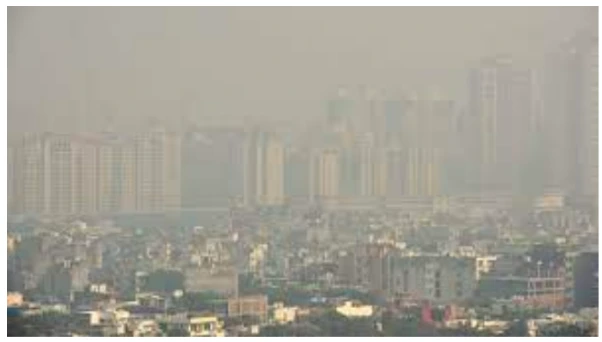Answer:
Approach:
- Introduction: Start with the context of air pollution in major Indian cities.
- Body:
- Explain how Delhi’s landlocked status contributes to pollutant accumulation, contrasting this with the sea breezes in Mumbai and Kolkata that aid pollutant dispersion.
- Discuss the role of humidity in coastal cities in air purification and how the harsh winters of Delhi aggravate smog and pollution.
- Compare the vehicular population and emission standards in the three cities, emphasizing Delhi’s struggle with higher emissions.
- Highlight the issue of agricultural residue burning around Delhi and its absence around Mumbai and Kolkata.
- Discuss the contribution of construction dust and industrial emissions to the air quality situation, comparing the scale and regulatory controls among the three cities.
- Analyze the effectiveness and strictness of pollution control policies in each city, pointing out any specific successes or failures.
- Incorporate comparative data on air quality indices, pollutant levels, or health impact reports to better substantiate the points.
- Conclusion: Conclude by emphasizing the need for tailored, effective, and immediate solutions considering each city’s unique challenges
|
Introduction:
Air pollution is a critical environmental issue that plagues urban centers globally, significantly impacting human health and ecological balance. Among Indian mega cities, Delhi grapples with more severe air pollution levels compared to Mumbai and Kolkata.
Body:
Comparative Analysis of Air Pollution in Delhi, Mumbai, and Kolkata:
- Geographical Disadvantages:
- Delhi is landlocked, unlike Mumbai and Kolkata, which are coastal cities. The coastal cities benefit from the sea breeze, which helps disperse air pollutants.
- In contrast, Delhi’s location allows pollutants to get trapped in the atmosphere, especially during winters when the wind speed is low.
- The phenomenon of temperature inversion, more common in Delhi, further traps pollutants close to the ground, worsening the air quality significantly.
- Climatic Conditions:
- The humidity levels in coastal regions, characteristic of Mumbai and Kolkata, help in settling dust and particulate matter, a facility Delhi, with its arid conditions, is deprived of.
- Cold winter months in North India, especially in Delhi, lead to the formation of smog, a significant health hazard. This is less prevalent in Mumbai and Kolkata due to their milder winter climate.
- Vehicular Emissions:
 Delhi has the highest number of registered vehicles among all Indian cities. Despite initiatives like the Odd-Even scheme, the vehicular emissions continue to be a significant contributor to its air pollution.
Delhi has the highest number of registered vehicles among all Indian cities. Despite initiatives like the Odd-Even scheme, the vehicular emissions continue to be a significant contributor to its air pollution.- The use of diesel vehicles, which emit more particulate matter than petrol ones, is comparatively higher in Delhi, exacerbating the problem.
- Stubble Burning:
- Agricultural stubble burning in nearby states like Punjab and Haryana significantly contributes to Delhi’s air pollution crisis. The landlocked nature of the city means these pollutants, brought by winds, remain concentrated in and around Delhi.
- Mumbai and Kolkata do not face an agricultural burning issue on a comparable scale.
- Construction and Industrial Activities:
- Both construction dust and industrial emissions contribute to PM2.5 levels, often found in dangerous concentrations in Delhi.
- Mumbai and Kolkata, with different industrial activities and more stringent controls on construction dust, fare slightly better in this aspect.
- Policy Implementation:
- Air quality management and policies have seen inconsistent implementation in Delhi, with issues like waste burning, dust from unpaved roads, and industrial emissions slipping through regulatory cracks.
- While Mumbai and Kolkata also struggle with pollution, some successful initiatives have been undertaken, such as stricter vehicular emission norms, relocation of certain industries, and better waste management practices, providing them with relatively better air quality.
| As per the World Air Quality Index, in recent years, Delhi has frequently recorded ‘unhealthy’ to ‘hazardous’ air quality levels, with PM2.5 often soaring beyond 300 µg/m³, particularly in the winter months. In contrast, Mumbai and Kolkata’s PM2.5 levels have remained relatively lower, usually in the ‘moderate’ to ‘unhealthy for sensitive groups’ categories.
Reports from the Central Pollution Control Board (CPCB) have consistently ranked Delhi among the most polluted cities in the country, often with AQI levels significantly higher than those of Mumbai and Kolkata. |
Conclusion:
The disparity in air quality levels among the mega cities of Delhi, Mumbai, and Kolkata can be attributed to a combination of geographical, meteorological, anthropogenic, and administrative factors. While each city has unique challenges, the situation in Delhi is particularly dire and highlights the need for urgent, comprehensive, and context-specific actions. Beyond the immediate health implications, the persistent air quality crisis underscores the need for sustainable urban planning, regional cooperation, public awareness, and strict adherence to environmental regulations to alleviate pollution in these burgeoning urban centers.
To get PDF version, Please click on "Print PDF" button.
 Delhi has the highest number of registered vehicles among all Indian cities. Despite initiatives like the Odd-Even scheme, the vehicular emissions continue to be a significant contributor to its air pollution.
Delhi has the highest number of registered vehicles among all Indian cities. Despite initiatives like the Odd-Even scheme, the vehicular emissions continue to be a significant contributor to its air pollution.
https://uploads.disquscdn.com/images/063a4425c9038f9cdba6760672f42bcf5ddff647d79e168d844b3c0f91b4be59.jpg https://uploads.disquscdn.com/images/3915efa08de07be3bc4e85e024182d110fcf39ac689799f2017ff7cd42badd01.jpg
https://uploads.disquscdn.com/images/05a34e6be5055a8f0d38a86386b808d69c57f94c64732c0e3801d61120ec6c64.jpg https://uploads.disquscdn.com/images/1954eed0532f172d348b139c24ddea137744a0669a29baa1501d022192708415.jpg
https://uploads.disquscdn.com/images/c67ebfd5effad2da6f0ee54f28137f2022e71bcd4661691429c516dbc7b3f7d2.jpg https://uploads.disquscdn.com/images/a583d9fc139a0cebf8e820dd4b9072c61f112220d777fe4fbfa0d3ed3f0aee25.jpg
https://uploads.disquscdn.com/images/27678ebd96c3b586c8edc13f38568cc9cb8b5547b0418d929c20784ed19be79c.jpg https://uploads.disquscdn.com/images/dc806f3caf6a8df0bc018edecdc79968ccea240b299c282de8e927d5f6e7138b.jpg
https://uploads.disquscdn.com/images/68f05a009586e95d3a4cf1e71a4fd2f590772f653d481adaf09c861a84f68448.jpg https://uploads.disquscdn.com/images/ea343d8ac65fddb1c2ab17acdb53eb608249bc72e7d106011b46cb89f24c4f43.jpg
https://uploads.disquscdn.com/images/b0bd85e631258dfd07681e9a60c9460f2ac71b3df4f19cde37dea708bc9e8713.jpg https://uploads.disquscdn.com/images/da83f70682bc2bc7398ba1f1aba914e06e1cc194007087d7eca5ad977a83f3bb.jpg
https://uploads.disquscdn.com/images/790214150eae590199986dde4e4d02f88035c39f5efd2c5c30f927a4ab69a033.jpg https://uploads.disquscdn.com/images/b10f3d6d6af00fef656843369bd437e7520af6dcdff70356c9bbff22c1c8801f.jpg
https://uploads.disquscdn.com/images/3c963d2f8ab331b77466f8dbfa026714c7a58f250fca7c3fbe8fe45d4d477a08.jpg https://uploads.disquscdn.com/images/dab6bfd6bd4afdb041a3d140bdf949d7ad4f93c4b0cf534f1a078ca44c0c64b8.jpg
https://uploads.disquscdn.com/images/9237c963e8a5178153b13adffc31cc10c359062c4a357d20ac2dc22edabe2a40.jpg https://uploads.disquscdn.com/images/2730ac64cc62db7a7fd7a2ece4c0d8541711a6e6a9bf8aafd09f3873b6104639.jpg
https://uploads.disquscdn.com/images/02534ce96f74c85d7a6e8c60982d58e20d71af297eefacf9abb8fb348125965d.jpg https://uploads.disquscdn.com/images/3bfbaacfe367fed5e4448a7aeaaa64f56cc7129dce4ff8b9250835bbbc8a3118.jpg
https://uploads.disquscdn.com/images/8e19315c33b86637701c78b608e38d2ac17be1118f487ff7dde487bc0b5f381d.jpg
https://uploads.disquscdn.com/images/8555195a88020745c1ea41b205451241252552a074958dcf22286c21d790d43d.jpg https://uploads.disquscdn.com/images/8555195a88020745c1ea41b205451241252552a074958dcf22286c21d790d43d.jpg
https://uploads.disquscdn.com/images/898e81b841eba41b0c84c32ba36fe09b952cae9f6c2184be2b4110744feaee82.jpg https://uploads.disquscdn.com/images/055efdfc26b500d0189c098686e8aece96e413fd613b251d238ccf31cde11f7e.jpg